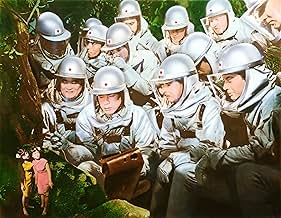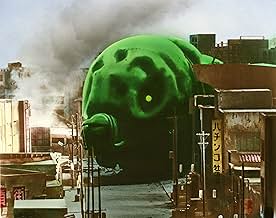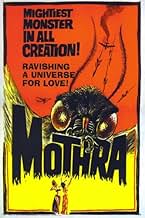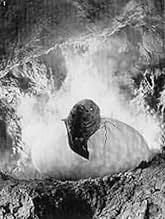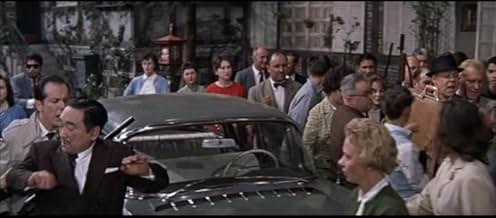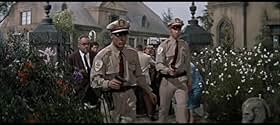Añade un argumento en tu idiomaAn expedition to Infant Island uncovers a native tribe and twin tiny fairy priestesses of a mythical deity, who sets out to rescue the pair after they are kidnapped by a greedy businessman.An expedition to Infant Island uncovers a native tribe and twin tiny fairy priestesses of a mythical deity, who sets out to rescue the pair after they are kidnapped by a greedy businessman.An expedition to Infant Island uncovers a native tribe and twin tiny fairy priestesses of a mythical deity, who sets out to rescue the pair after they are kidnapped by a greedy businessman.
- Dirección
- Guión
- Reparto principal
- Premios
- 2 nominaciones en total
- Shobijin (Twin Fairy)
- (as Yumi Ito)
- Shobijin (Twin Fairy)
- (as Emi Ito)
- Kurâruku Neruson
- (as Jerî Itô)
- Military Advisor
- (as Yoshibumi Tajima)
- Nelson's Henchman
- (as Hiroshi Iwamoto)
- Ship Survivor
- (escenas eliminadas)
Reseñas destacadas
If the original Godzilla was the '50s classic kaijyu movie, this is that of the '60s, spawning many movies that follows featuring Mothra.
This movie was created on the following year Japan signed the "Treaty of mutual cooperation and security between Japan and U.S." of 1960 and reflects the politically charged atmosphere against US at the time in Japan. For instance, country Rorisika is a combined name of Russia, and America (in the original novel, the name was even more obvious Russirica, but was changed for the world wide release of the movie), and New Kirk city is an obvious synonym for New York city. US and Russia by the way were the only countries in the world performing hydrogen bomb experiments at the time, and No. 2 Genyomaru's, encounter with the test was also a hidden criticism against these experiments.
In the original novel, the location where Mothra spews the cocoon is the parliament building, but this was viewed as a political statement against the said treaty, and was changed to Tokyo tower. The movie features a real life twins The Peanuts (Emi and Yumi Eto) who were popular singers in Japan at the time. The Mothra song they sang were written by Tomoyuki Tanaka, Ishiro Honda, and Shinichi Sekizawa first in Japanese, and Indonesian student residing in Japan at the time translated it into his language. The original manuscript of this handwritten song is now displayed in Yuji Koseki (who was the composer for this song) museum in Fukushima city Japan.
The plot and special effects are tour de force. One of Mothra's lava costumes had 8 men in it with Godzilla suit actor Haruo Nakajima taking the lead. Mothra is the first kaijyu that's not just out for destruction, but is a protector of the environment. When the Mothra lava spews silk, it really looks real. The silk was made from rubber contact cement thinned down with solvent and shot out of Mothra's mouth using air brush. Actor Hiroshi Koizumi reprises his role as Shinichi Chujyo in 2003 movie Godzilla vs Mecha Godzilla Tokyo SOS after 42 years this movie was made.
Still after half a century, this is one of the best kaijyu movie ever created.
The colors are bright. The story is strange. Mothra doesn't appear until halfway through the movie. The tiny singers are the strangest cinematic creations and that's in the same movie as Mothra. There is a lot of miniature and green screen work. This is a classic Japanese monster movie.
Mothra is a sympathetic character which became popular and went on to co-star in many more Toho adventures. The female creature starts out as a gigantic crawling caterpillar, but late in the movie emerges out of its self-spun cocoon, as a huge and colorful flying moth that causes intense catastrophic winds when flapping its wings. Jerry Ito is a perfect hateful lead villain, but he is counterbalanced partly by the agreeable presence of comedian Frankie Sakai on the side of the good guys. The story is involving, and the pacing very comfortable. I have always been a big fan of the charming little song that the twin fairies sing in honor of their savior, Mothra. The English language version is well dubbed, and there are some differences between the U.S. and original Japanese versions; but either one is good and enjoyable.
*** out of ****
A greedy showman/explorer Clark Nelson (Jerry Ito) finds twin fairies on an island off Japan. He displays them on the Tokyo stage, where they sing what sounds like a lullaby. It is actually a telepathic distress call to their god and protector, Mothra, a giant caterpillar. Mothra comes to Tokyo, searching for the girls and Nelson, destroying most of the city in it's path. The chase goes from Tokyo to Newkirk City (I guess this is suppose to be a little real life hamlet just south of Yonkers!) What I really love about MOTHRA is that it has many things most other monster movies don't. The hero is a comical, older, tubby reporter, a sort of Japanese Lou Costello. The monster is actually pretty. In the Japanese version, there is some wonderful slapstick and odd humor. THese elements make this film so unique. Director Inoshiro Honda was best friends with more famous and more respected Japanese director Akira Kurosawa. Kurosawa loved Honda's monster movies and according to rumor, yearned to make one himself.
Here we see the debut of Mothra getting her own film, a character who would go onto be one of the most commonly seen creatures.
It tells the story of a rich businessman who kidnaps two tiny ladies from their native land to use in show business. In doing so Mothra was summoned to retrieve them using any means necessary even if it means the entire destruction of Tokyo in the process.
Mothra actually looks good for it's day, there is no man in a goofy suit as usual and Mothra in both infant and adult forms look far better than you'd expect.
The cast are less generic than usual, the lead is fairly comedic and the whole thing feels above average within this original kaiju film.
Certainly one of the better films of the series that I've seen thus far, but still highly niche.
The Good:
Some of the sfx are quite good for their day
Character development is better than usual
The Bad:
Still highly cheesy
A few weak points in the plot
Things I Learnt From This Movie:
Stowaways are not only not punished but they are given guns
A gigantic monster worm in a coccoon isn't newsworthy
The transitional phase for giant moths is a peanut
¿Sabías que...?
- CuriosidadesThe Mothra larva was the largest costume Toho would create in the Showa era. The Mothra larva seen rampaging through Tokyo's neighborhood was about 7 feet tall and just over 31 feet long. Weighing about 265 pounds (120 kilograms), a total of eight actors were needed to perform and operate the Mothra larva.
- PifiasWhen Dr. Shinichi is showing the symbols he discovered in the cave to Senchan, you can see someone in black pants and shoes walking down the stairs behind Senchan's head.
- Citas
[the protagonists confront Nelson to return Mothra's fairies back to Infant Island]
Dr. Shinichi Chujo: I want you to stop this inhumanity and return them to their island.
Nelson's Henchman: Inhumanity? Ridiculous. Strictly speaking they're just scientific data.
Clark Nelson: Those fairies aren't human. They're merchandise.
- Créditos adicionalesIn the credits for the U.S. version, including promo material released by Columbia Pictures, Eurasian model Jerry Ito (who plays the villianous Mr. Nelson) is billed as "Jelly Ito."
- Versiones alternativasThe American Version also edited the birth of Mothra sequence, cutting out a good 40 seconds to make it more elaborate
- ConexionesEdited into Los monstruos invaden la Tierra (1965)
Selecciones populares
Detalles
Taquilla
- Recaudación en todo el mundo
- 90 US$
- Duración
- 1h 41min(101 min)
- Mezcla de sonido
- Relación de aspecto
- 2.35 : 1



